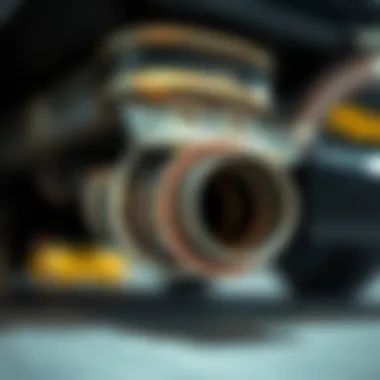Understanding the 2006 Chevy Express 2500 Catalytic Converter


Intro
In the world of automotive maintenance, the catalytic converter often doesn't get the spotlight it deserves. Especially in vehicles like the 2006 Chevy Express 2500, this component plays a pivotal role in both performance and environmental compliance. The catalytic converter is not just an exhaust part; it is integral to the vehicle's ability to function efficiently while reducing harmful emissions.
For enthusiasts and everyday drivers alike, having a grasp on how this unit operates, the common issues it faces, and how it fits into the larger picture of vehicle maintenance is essential. The 2006 Chevy Express 2500, which boasts considerable versatility as a workhorse, is a vehicle in which the catalytic converter must be well understood to ensure optimum operation and longevity.
This article aims to provide a deep dive into the essentials of the 2006 Chevy Express 2500 catalytic converter, aiming to enlighten and educate those looking for comprehensive insights about this crucial component. With the heightened awareness of environmental regulations and performance standards in the automotive industry, knowing how the catalytic converter interacts with the vehicle can be crucial for all drivers.
Prelims to Catalytic Converters
Catalytic converters play a pivotal role in the functioning of modern vehicles, particularly in ensuring that internal combustion engines comply with stringent emission norms. Understanding the nuances of these devices is crucial for anyone who aims to delve into vehicle maintenance, particularly for the 2006 Chevy Express 2500.
Catalytic converters are more than just an accessory; they function as a vital component of the exhaust system. They work by converting harmful gases produced during combustion into less harmful pollutants before they exit the tailpipe. This proactive measure in emissions control serves both environmental purposes and legal compliance.
Role in Emission Control
In the realm of emission control, catalytic converters serve as the first line of defense against pollution. By employing a blend of chemical reactions within, they transform toxic gases such as carbon monoxide, hydrocarbons, and nitrogen oxides into safer byproducts like carbon dioxide and nitrogen.
The importance of this transformation cannot be overstated, given the mounting concerns over air quality and environmental sustainability. Regulatory agencies, such as the Environmental Protection Agency (EPA) in the United States, have put rigorous requirements in place, which mandates that vehicles use effective catalytic converters. Without these devices, even the mightiest of engines would belch an unacceptable amount of pollutants into the atmosphere.
Moreover, a well-functioning catalytic converter not only safeguards the environment but also protects engine components from damage caused by harmful emissions. Thus, understanding how these devices operate is fundamental for owners of the Chevy Express 2500 who are concerned about upkeep and compliance.
Overview of Different Types
Not all catalytic converters are crafted equal; in fact, there are several variations, each designed for specific applications. The primary types include:
- Two-way catalytic converters: Common in older vehicles, these are responsible for oxidizing carbon monoxide and hydrocarbons.
- Three-way catalytic converters: These are the standard in modern vehicles, managing to oxidize carbon monoxide and hydrocarbons while also reducing nitrogen oxides.
- Diesel oxidation catalysts: Engineered specifically for diesel engines, these focus primarily on oxidizing pollutants within diesel exhaust.
- Lean NOx traps: These devices are designed to reduce nitrogen oxides in lean-burn engines, which is a growing trend in fuel-efficient technology.
Each type of catalytic converter has its set of advantages and disadvantages. For the Chevy Express 2500, the common type is the three-way catalytic converter, which effectively balances emissions control with engine performance. It’s important to be aware of the specific type that matches your vehicle, as this affects both the cost of replacement and the overall efficiency of the emission system.
Design Specifics of the Chevy Express
The design specifics of the 2006 Chevy Express 2500's catalytic converter play a crucial role in ensuring the vehicle's overall performance and compliance with emission standards. Understanding its construction and how it integrates within the exhaust system reveals much about its efficiency and the sophisticated engineering that ensures it operates effectively.
Construction and Materials
The construction of the catalytic converter is paramount to its functionality. The 2006 Chevy Express 2500 is equipped with a catalytic converter designed using high-grade materials that can withstand extreme temperatures and corrosive elements present in exhaust gases. Generally, the core is made from a ceramic or metallic substrate, coated with precious metals like palladium, platinum, and rhodium. These metals facilitate the chemical reactions needed to convert harmful pollutants into less harmful emissions.
Moreover, this specific catalyst design helps to ensure a quicker warm-up time, thus reducing harmful emissions during the initial engine operation phase. A well-designed catalytic converter is integral for maintaining the vehicle’s emissions performance over time, allowing it to meet both state and federal compliance standards.
In addition, the construction includes features aimed at minimizing backpressure in the exhaust system. This allows for better engine efficiency, resulting in increased power and performance. In contrast, a poorly constructed or damaged catalytic converter can lead to significant power loss, making it essential for vehicle owners to be aware of its condition over time.
Integration within the Exhaust System
The integration of the catalytic converter within the 2006 Chevy Express 2500's exhaust system is another critical topic worthy of discussion. Located between the engine's exhaust manifold and the muffler, the converter is positioned intentionally to maximize its efficiency in treating exhaust gases before they leave the vehicle.
This integration allows for seamless flow of exhaust gases through the system. The design ensures that exhaust gases undergo the necessary chemical reactions while minimizing restrictions that could hinder the engine's performance. An effective exhaust system will ensure that gases are adequately processed through the catalytic converter, contributing significantly to improving fuel economy and reducing emissions.


It's fascinating how this component interacts with other parts of the exhaust system, linking to oxygen sensors that monitor the levels of unburned oxygen. This feedback aids the engine control unit in optimizing combustion, further enhancing the catalytic converter's ability to reduce harmful substances.
"The strength of the 2006 Chevy Express 2500's performance lies in its well-thought-out integration of the catalytic converter, a testament to engineering precision."
Understanding these design specifics not only highlights the importance of the catalytic converter's role but also indicates the need for regular inspection. This maintenance can ensure its longevity and performance, providing peace of mind for those who utilize this vehicle for work or leisure.
Common Issues Associated with the Catalytic Converter
Understanding the common issues related to the catalytic converter is vital for maintaining the performance and efficiency of the 2006 Chevy Express 2500. These problems, if left unattended, can lead to serious consequences for both the engine and the vehicle’s overall functionality. Identifying the signs and causes of failure early on can save drivers time and money, improving both the lifespan of the vehicle and the experience of operating it.
Signs of Failure
Loss of Power
Loss of power can manifest as a notable decrease in acceleration or an inability to reach higher speeds. This specific aspect is crucial because it directly impacts the driving experience. When a catalytic converter begins to fail, it can become clogged, which restricts the flow of exhaust gases. Consequently, the engine struggles, resulting in sluggish performance. This sign is a beneficial point of focus for this article as it represents how immediate and noticeable the impacts of a failing catalytic converter can be.
The key characteristic of loss of power is its sudden onset. Drivers might find themselves unusually slow on the highway, making it clear that something isn’t quite right under the hood. One unique feature of this issue is that it often leads to a cascade of further problems, such as increased wear on the engine from overworking. However, a significant advantage here is that it often leads to the vehicle owner seeking repairs sooner rather than later, potentially avoiding more extensive issues down the line.
Check Engine Light
The check engine light is like an unsung hero in the car’s dashboard — often overlooked but incredibly important. When this light pops on, it signals potential problems with numerous engine components, including the catalytic converter. A glowing light can serve as an early warning sign, pushing owners to investigate further and catch potential issues before they snowball. It has become a common friend to many in the automotive realm, making it a popular choice to discuss in regards to catalytic converters.
The key feature of the check engine light is its role as a diagnostic flag. Unlike other indicators that might relate to more benign issues, this light is a cry for attention. It can be both an advantage and advantage; while it raises awareness about problems, it does so without specifying the exact issue, which often requires a more thorough inspection. This mysterious nature of the check engine light can lead to procrastination in dealing with it.
Causes of Malfunction
Contaminated Fuel
Contaminated fuel is a notorious troublemaker for any vehicle’s engine and exhaust system. Fuel impurities can originate from various sources, like old or poorly-stored fuel, leading to a direct impact on catalytic converter performance. This aspect is critical because contaminated fuel can cause chemical malfunctions in the catalytic converter, preventing it from properly converting harmful pollutants. As such, understanding this cause helps guide proper fuel management practices.
Highlighting its key characteristic, contaminated fuel can create a chain reaction of complications within the vehicle. Issues like engine misfires can occur as a result, leading to a cyclical pattern of difficulties that reflects an overall neglect in maintenance. The unique feature of this issue is its variety — different types of contaminants can lead to different symptoms, making it a multifaceted problem for car owners. If left unaddressed, it can result in costly repairs down the road, making its awareness crucial for any Chevy Express owner.
Engine Misfires
Engine misfires represent a significant contributor to catalytic converter issues and overall vehicle inefficiency. When an engine misfires, it indicates that the engine is not firing as it should, resulting in unburned fuel reaching the catalytic converter. This not only affects power but can also damage the catalytic converter over time. As a consequence, recognizing engine misfires can serve as an essential reminder to thoroughly inspect fuel mixtures and the ignition system.
The key characteristic of engine misfires is the abruptness of the situation; one moment the engine runs smoothly, and the next it’s sputtering like a teenager’s first attempt at driving. This unpredictability highlights the importance of vigilant monitoring and timely maintenance. The unique feature of this issue here is how it feedbacks into the vehicle’s performance. Ignoring misfires can lead to a situation where the owner faces escalating repair bills — effectively costing more than a simple, timely fix would. It captures the essence of why preventative maintenance is so beneficial for vehicle longevity.
Replacement Considerations
Replacing a catalytic converter is not something one often takes lightly, especially when it comes to a vehicle like the 2006 Chevy Express 2500. This component is pivotal in controlling emissions and ensuring the engine operates efficiently. When considering a replacement, several elements come into play that can significantly influence decision-making for vehicle owners and enthusiasts alike.
OEM vs Aftermarket Options
When the time comes to replace the catalytic converter, the first major consideration is whether to go with an Original Equipment Manufacturer (OEM) part or an aftermarket option. OEM parts are made specifically for the Chevy Express 2500 by the original manufacturer, ensuring compatibility and reliability. These parts, while often more expensive, limit the potential for future issues. On the other hand, aftermarket converters can be less costly and widely accessible. However, their quality can vary substantially, with some mimicking OEM specifications while others fall short.
Take into account: Choosing between OEM and aftermarket isn't just about the price tag; it can affect performance, longevity, and even emissions compliance, which can be critical in certain regions.
One must also weigh other factors such as warranty coverage, available installation support, and the potential need for modifications when installing aftermarket options. For the discerning owner, doing thorough research on reputable aftermarket brands can yield beneficial outcomes without breaking the bank.


Cost Implications
The financial aspect of replacing a catalytic converter can indeed set back many owners. First and foremost, the price of the part itself can vary tremendously between OEM and aftermarket options. Generally, you might see OEM catalytic converters for the 2006 Chevy Express 2500 ranging from $1,000 to $3,000 when including labor for installation.
In contrast, aftermarket converters tend to be more wallet-friendly, often costing between $200 and $600, not including labor. While the tempting low cost of aftermarket parts is attractive, one must keep in mind the potential hidden costs associated with non-compliance with emissions regulations or the need for further repairs if quality proves to be subpar. Poor quality parts can lead to a domino effect, causing downstream issues that might result in more costly repairs down the road.
Keeping an eye on both parts and labor costs is crucial; ensure to inquire with local garages or dealerships about prices before making a final decision. It's wise to consider what's at stake in terms of functionality and environmental impact when selecting a catalytic converter replacement, as what may seem like a small financial investment today could translate into larger expenses and complications later on.
Performance Impacts of a Faulty Catalytic Converter
The performance of your vehicle hinges on multiple factors, and one often overlooked component is the catalytic converter. When this device falters, it can significantly affect not just the emission levels but also the overall performance of the vehicle, particularly the 2006 Chevy Express 2500. Understanding these impacts is crucial for any owner. A faulty catalytic converter varies in symptoms and severity, often leading to noticeable changes in engine behavior and efficiency.
Engine Efficiency
Engine efficiency is paramount for maintaining the health of any vehicle, including the Chevy Express 2500. When the catalytic converter malfunctions, it creates a bottleneck within the exhaust system.
- Back Pressure: An invalid converter can generate excessive back pressure, which forces the engine to work harder than it should. This increase can impede the flow of exhaust gases, resulting in reduced horsepower.
- Horsepower Loss: Over time, the lack of proper exhaust flow leads to a discernible dip in the engine's power output. The car may feel sluggish, especially when accelerating or climbing hills. The drive experience can dim, transforming what was once a smooth ride into a frustrating endeavor.
- Heat Build-Up: Moreover, a faulty converter can retain heat, leading to increased temperatures in the engine compartment. This condition may cause additional strain on engine components, resulting in further wear and tear over time. An inefficient engine could mean more trips to the mechanic, costing both time and money.
In short, loss of engine efficiency not only impacts driving pleasure but can also escalate repair costs. Regular inspections and maintenance can prevent these issues, keeping your engine running smoothly.
Fuel Economy
Fuel economy is another critical aspect often affected by a malfunctioning catalytic converter. When the converter isn’t functioning well, the entire fuel-air mixture can become skewed.
- Increased Fuel Consumption: The engine compensates for insufficient exhaust flow by burning more fuel to maintain performance. Drivers may find themselves filling up at the gas station more frequently, feeling the pinch in their wallets. This inefficiency translates to a decrease in miles per gallon, which inconveniences both the driver and the environment.
- Environmental Impact: In addition to personal financial burdens, poor fuel economy also leads to increased emissions. Driving a vehicle with a compromised catalytic converter not only affects fuel efficiency but generates greater levels of pollutants being released into the air, forming a potential health hazard and contributing to larger environmental concerns.
Considering these factors, maintaining your vehicle’s catalytic converter is not just an engine concern; it’s a step towards being an environmentally responsible driver too. Keeping an eye out for warning signs of failure can make a world of difference in your vehicle’s performance.
"A stitch in time saves nine"�—addressing issues early can prevent bigger problems down the line.
To sum up, the impact of a failing catalytic converter stretches far beyond performance metrics. Gas mileage, engine efficiency, and overall vehicle health can all take a hit, underscoring the importance of maintenance and timely repairs. Protecting your 2006 Chevy Express 2500 from these pitfalls can lead to a more enjoyable and economically sustainable driving experience.
For further reading on catalytic converters and their significance, consider checking resources from EPA and Wikipedia.
Regulatory Aspects of Catalytic Converters
The regulatory landscape surrounding catalytic converters is a cornerstone of environmental protection and vehicle compliance. For the 2006 Chevy Express 2500, understanding these aspects is crucial for both owners and potential buyers. Catalytic converters help reduce harmful emissions, ensuring that vehicles adhere to government standards. Without proper compliance, vehicle operation can lead to legal implications and environmental hazards. Recognizing the relevance of these regulations gives insight into why maintaining the catalytic converter is not just a matter of performance but also adherence to legal standards.
Emissions Standards Compliance
One of the primary roles of catalytic converters is to meet emissions standards set forth by agencies like the Environmental Protection Agency (EPA) in the United States. These standards dictate the amount of harmful pollutants that a vehicle can emit:
- Hydrocarbons (HC): Volatile compounds that can contribute to smog.
- Nitrogen Oxides (NOx): Gasses that have significant health and environmental impacts.
- Carbon Monoxide (CO): A colorless gas that can be deadly in high concentrations.
For the 2006 Chevy Express 2500 specifically, monitoring emissions is essential, as this model must comply with Tier 2 emissions regulations. If the vehicle’s catalytic converter is impaired, it might not pass the stringent emissions test, leading to hefty fines or the inability to legally operate the vehicle. Owners should frequently check for service lights and monitor for any signs that may indicate the failure of the catalytic converter, as this is the first step toward ensuring compliance. As these standards continue to evolve, it is vital for vehicle owners to stay informed about emissions compliance and any related changes in local or federal laws.
Legal Implications of Removal


Removing or tampering with the catalytic converter is not simply a decision made lightly. In fact, it carries serious legal repercussions:
- Fines: Removing a catalytic converter can lead to hefty fines from the EPA for running an illegal vehicle.
- Failing Inspections: Most states require emissions testing, and a vehicle without a catalytic converter will automatically fail.
- Insurance Issues: Modifications, especially illegal ones, can void insurance policies, leaving owners exposed to financial loss.
Additionally, some regions may have more stringent laws than others. For instance, California has laws prohibiting the removal of catalytic converters and offers strict penalties for non-compliance.
"The catalytic converter is a bridge between responsibility and regulation, echoing the need for both individual and environmental well-being."
To summarize, understanding the regulatory implications surrounding catalytic converters is imperative for maintaining compliance, ensuring vehicle performance, and avoiding potential legal issues. Owners should approach modifications with caution and remain well-informed to navigate the complexities of vehicle regulations.
Maintenance Practices to Ensure Longevity
Taking care of a catalytic converter is not just an afterthought; it’s absolutely essential if you're aiming for a long-lasting vehicle experience, especially with the 2006 Chevy Express 2500. Regular maintenance improves functionality, enhances fuel efficiency, and can even save you from costly replacements. By focusing on specific practices, you can keep the engine humming and make sure that converter does its job seamlessly.
Regular Inspections
When it comes to keeping your Chevy Express in tip-top shape, incorporating regular inspections into your routine is key. Think of it like a yearly check-up for your health; the sooner you catch a problem, the less painful the remedy will be.
For the catalytic converter, check for signs of corrosion or damage during your routine maintenance. Here’s what you should be on the lookout for:
- Physical Damage: Visual cracks or dents might suggest that the converter has taken some hits, which could lead to inefficient operation.
- Loose Connections: Ensure that the connections to the exhaust system are tight and secure. Loose parts can contribute to exhaust leaks, leading to a reduction in performance.
- Under-the-Hood Monitoring: Every now and then, take a peek under the hood to see if there are any irregularities with wiring or components nearby. An ounce of prevention is worth a pound of cure.
Setting a schedule for these inspections—perhaps every oil change or at least quarterly—can go a long way. Regular check-ins can allow you to catch issues before they escalate into costly repairs, which, when it comes to catalytic converters, can be pricey.
Fuel Quality Management
Next up is the fuel itself. Believe it or not, the type of fuel you put into your 2006 Chevy Express 2500 plays a significant role in the longevity of your catalytic converter. Not all fuels are created equal. Opting for low-quality or contaminated fuel can introduce problems that can choke your catalytic converter.
Consider these points:
- Use High-Quality Fuel: Premium fuels might carry a higher price tag, but they often come with better additives that are beneficial for engine performance. Brands like Chevron or Shell offer fuels that keep your engine running smoothly.
- Avoid Ethanol: If possible, steer clear of high-ethanol blends, especially in older vehicles. The corn-based ethanol can lead to poor combustion, creating residue that can build up and clog your catalytic converter.
- Monitor Additives: While some additives boast performance improvements, ensure they're reputable. Poorly designed products can cause more harm than good, particularly to catalytic converters.
Focusing on fuel quality is not just about your car’s performance; it's about prolonging the life of key components, including the catalytic converter.
"Regular maintenance and good fuel choices are the double whammy for ensuring your catalytic converter stays in prime shape. Invest time in these areas to reap benefits down the road."
In summary, maintenance practices are your best friends when it comes to maximizing the service life of the catalytic converter in the 2006 Chevy Express 2500. Regular inspections and careful considerations regarding fuel quality are two pillars of an effective maintenance strategy. These efforts can lead to a smoother ride, better fuel economy, and peace of mind as you drive.
Finale
In reflecting upon the various aspects of the 2006 Chevy Express 2500 catalytic converter, it becomes evident how pivotal this component is within the vehicle's ecosystem. Understanding its role in emission control and its integration within the exhaust system enables drivers and enthusiasts alike to appreciate not just function but longevity and environmental compliance. It’s important to grasp that failing to maintain this part can result in significant ramifications — from diminished performance to legal consequences associated with emissions violations.
Summation of Key Points
- Crucial Role: The catalytic converter plays a significant role in reducing harmful emissions, an aspect that's increasingly relevant in today's eco-conscious automotive landscape.
- Watch for Signs: Diagnosing issues early can save time and prevent costly repairs. Symptoms like loss of power or warning lights should not be ignored.
- Replacement Choices: Whether opting for OEM or aftermarket parts, understanding potential costs and impacts on performance is crucial for informed decisions.
- Maintenance is Key: Regular inspections and maintaining fuel quality can extend the life of the catalytic converter significantly.
Final Thoughts on the Chevy Express
When it comes to the Chevy Express 2500, it’s clear that the catalytic converter is more than just a mere component; it is a central player in the wider game of engine performance and environmental responsibility. A well-maintained catalytic converter can significantly enhance your vehicle's efficiency and compliance with regulations, setting the stage for smoother and more responsible driving. In today’s world, where environmental issues are front and center, vehicle owners must prioritize the sustainability efforts tied to their automotive choices.
Maintaining the Chevrolet Express not only engages the driver's sense of responsibility but also fosters a deeper connection with the machine itself, ensuring that it runs optimally for years to come.
For further reading, visit Wikipedia on Catalytic Converters and explore discussions about the Chevy Express on platforms such as Reddit.
Embracing a proactive approach towards maintenance and understanding the specifics surrounding the catalytic converter positions any owner to navigate potential challenges, ensuring a smoother ride in the ever-evolving automotive landscape.







